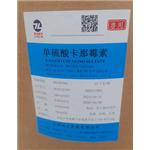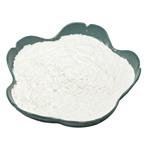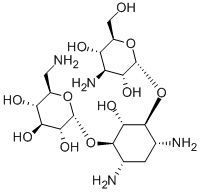- KANAMYCIN
-

- $0.00 / 15bou
-
2024-04-25
- CAS:59-01-8
- Min. Order: 15bou
- Purity: >765/mg
- Supply Ability: 15000bou
- Kanamycin
-

- $0.00 / 25KG
-
2023-09-08
- CAS:59-01-8
- Min. Order: 1KG
- Purity: 99%
- Supply Ability: 50000KG/month
- Kanamycin
-

- $1.90 / 1KG
-
2023-03-06
- CAS:59-01-8
- Min. Order: 1KG
- Purity: 99%
- Supply Ability: 10 ton
|
| Product Name: | KANAMYCIN | | Synonyms: | y-alpha-d-glucopyranosyl-(1-4))-2-deoxy-;Kannamycin Monosulfate;KANAMYCIN BASE ENTERPRISE STANDARD;1-O-[(1R)-2α-Hydroxy-3β-(3-amino-3-deoxy-α-D-glucopyranosyloxy)-4α,6α-diaminocyclohexane-1β-yl]-6-amino-6-deoxy-α-D-glucopyranose;4-O-(6-Amino-6-deoxy-α-D-glucopyranosyl)-6-O-(3-amino-3-deoxy-α-D-glucopyranosyl)-2-deoxy-D-streptamine;(2R,3S,4S,5R,6R)-2-(aminomethyl)-6-[(1R,2R,3S,4R,6S)-4,6-diamino-3-[(2S,3R,4S,5S,6R)-4-amino-3,5-dihydroxy-6-methylol-tetrahydropyran-2-yl]oxy-2-hydroxy-cyclohexoxy]tetrahydropyran-3,4,5-triol;KANAMYCIN BASE;4))-2-deoxy-y-alpha-d-glucopyranosyl-( | | CAS: | 59-01-8 | | MF: | C18H36N4O11 | | MW: | 484.5 | | EINECS: | 200-411-7 | | Product Categories: | | | Mol File: | 59-01-8.mol |  |
| | KANAMYCIN Chemical Properties |
| | KANAMYCIN Usage And Synthesis |
| Description | Kanamycin is a well-known bactericidal antibiotic. It belongs to the aminoglycoside antibiotic group. It can be used for the treatment of various pathogens including E. coli, Proteus species (both indole-positive and indole-negative), Enterobacter aerogenes, Klebsiella pneumoniae, Serratia marcescens and Acinetobacter species1-4. Kanamycin is isolated from the bacterium Streptomyces kanamyceticus and its most commonly used form is kanamycin sulfate5. Aminoglycoside-type drug take actions through “irreversibly” binding to the 30S subunit of the ribosome, further blocking the protein synthesis. Kanamycin kills bacteria cells binds to four nucleotides of 16S rRNA and a single amino acid of protein S12. This interferes with decoding site in the vicinity of nucleotide 1400 in 16S rRNA of 30S subunit. This region interacts with the wobble base in the anticodon of tRNA. This leads to interference with the initiation complex, misreading of mRNA so incorrect amino acids are inserted into the polypeptide leading to nonfunctional or toxic peptides and the breakup of polysomes into nonfunctional monosomes5.
| | Sources |
- Pindell, M. H. "The pharmacology of kanamycin--a review and new developments." Annals of the New York Academy of Sciences 132.2(1966): 805–810.
- https://www.annualreviews.org/doi/pdf/10.1146/annurev.bi.42.070173.002351
- Spelman, D. W., M. Mcdonald, and W. J. Spicer. "Aminoglycoside antibiotic agents: a review." Medical Journal of Australia 151.6(1989): 346.
- https://en.wikipedia.org/wiki/Kanamycin_A
- https://www.drugbank.ca/drugs/DB01172
| | Uses | Antibacterial Kantrex (Apothecon). | | Uses | Kanamycin A is an antibiotic complex produced by Streptomyces kanamyceticus Okami & Umezawa from Japanese soil. Comprised of three components, kanamycin A, the major component, and kanamycins B and C, two minor congeners. Antibacterial. | | Indications | Kanamycin, O-3-amino-3-deoxy-α-D-glucopyranosyl-(1→6)-O-[6-deoxy-
6-amino-α-D-glucopyranosyl-(1→4)]–2-deoxy-D-streptamine (32.4.6), is isolated from a
culture fluid of the actinomycete Streptomyces kanamyceticus, which produces three
antibiotics—kanamycins A, B, and C.
Kanamycin A is similar to streptomycin and neomycines, and it possesses a broad spec�trum of antimicrobial action. It is active with respect to most Gram-positive and Gram�negative microorganisms (staphylococci, colon bacillus, klebisella, Fridlender’s bacillus,
proteus, shigella, salmonella).
It is used to treat sepsis, meningitis, osteomyelitis, peritonitis, pneumonia, pyelonephri�tis, pyelocystitis, infected wounds, and post-operational, purulent complications that are
caused by microorganisms sensitive to this drug. Kanamycin is used to treat tuberculosis
of the lungs and other organs upon resistance to other antituberculosis drugs. Synonyms of
this drug are karmycin, kamaxin, resistomycin, and many others. | | Definition | ChEBI: Kanamycin A is a member of kanamycins. It has a role as a bacterial metabolite. It is a conjugate base of a kanamycin A(4+). | | Brand name | Klebcil (King). | | Antimicrobial activity | It is active against staphylococci, including
methicillin-resistant strains. Other aerobic and anaerobic
Gram-positive cocci and most Gram-positive rods are
resistant, but M. tuberculosis is susceptible. It is widely active
against most aerobic Gram-negative rods, except Burkholderia
cepacia and Sten. maltophilia. Treponema pallidum, Leptospira
and Mycoplasma spp. are all resistant. | | Acquired resistance | Resistance is usually plasmid borne and due to enzymatic
inactivation of the drug by enzymes that also inactivate gentamicin
or tobramycin . Resistance due to
reduced permeability is also encountered. | | Pharmacokinetics | Cmax 500 mg intramuscular: c.15–20 mg/L after 1 h
Plasma half-life: 2.5 h
Volume of distribution: 0.3 L/kg
Plasma protein binding: Low
Absorption and distribution
Very little is absorbed from the intestinal tract. The peak plasma
concentration in the neonate is dose related: concentrations of
8–30 mg/L (mean 18 mg/L) have been found 1 h after a 10 mg/kg
dose. The drug is confined to the extracellular fluid. The concentration
in serous fluids is said to equal that in the plasma,
but it does not enter the CSF in therapeutically useful concentrations
even in the presence of meningeal inflammation.
Excretion
It is excreted almost entirely by the kidneys, almost exclusively
in the glomerular filtrate. Up to 80% of the dose appears
unchanged in the urine over the first 24 h, producing concentrations
around 100–500 mg/L. It is retained in proportion to
reduction in renal function. Less than 1% of the dose appears
in the bile. In patients receiving 500 mg intramuscularly preoperatively,
concentrations of 2–23 mg/L have been found in
bile and 8–14 mg/kg in gallbladder wall. | | Clinical Use | Formerly used for severe infection with susceptible organisms,
it has largely been superseded by other aminoglycosides. | | Side effects | Intramuscular injections are moderately painful, and minor
side effects similar to those encountered with streptomycin
have been described. Eosinophilia in the absence of other manifestations of allergy occurs in up to 10% of patients.
Other manifestations of hypersensitivity are rare.
As with other aminoglycosides, the most important toxic
effects are on the eighth nerve and much less frequently on
the kidney. Renal damage is seen principally in patients with
pre-existing renal disease or treated concurrently or sequentially
with other potentially nephrotoxic agents. The drug
accumulates in the renal cortex, producing cloudy swelling,
which may progress to acute necrosis of proximal tubular
cells with oliguric renal failure. Less dramatic deterioration
of renal function, particularly exaggeration of the potential
nephrotoxicity of other drugs or of existing renal disease, is
of principal importance because it increases the likelihood of
ototoxicity.
Vestibular damage is uncommon but may be severe and
prolonged. Hearing damage is usually bilateral, and typically
affects frequencies above the conversational range. Acute toxicity
is most likely in patients in whom the plasma concentration
exceeds 30 mg/L, but chronic toxicity may be seen in patients
treated with the drug over long periods. Auditory toxicity may
be potentiated by concurrent treatment with potent diuretics
like ethacrynic acid. If tinnitus – which usually heralds the onset
of auditory injury – develops, the drug should be withdrawn.
Neuromuscular blockade is seen particularly in patients
receiving other muscle relaxants or suffering from myasthenia
gravis and may be reversed by neostigmine. |
| | KANAMYCIN Preparation Products And Raw materials |
|